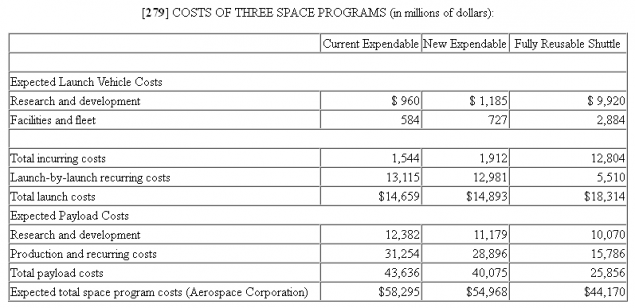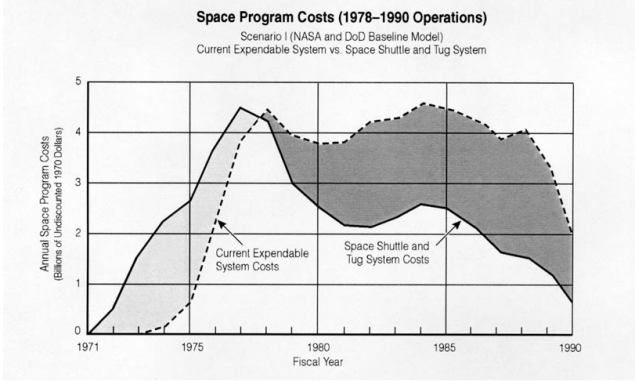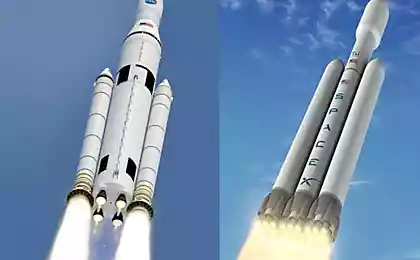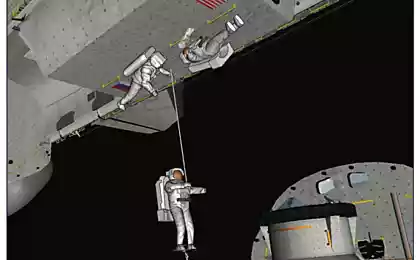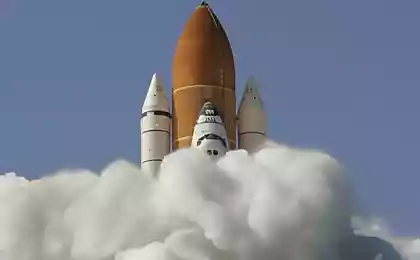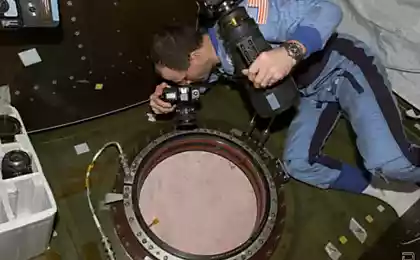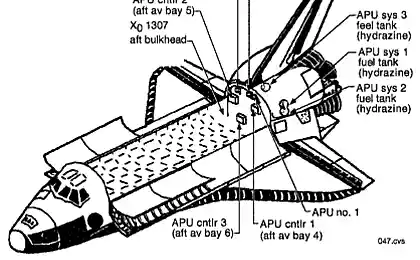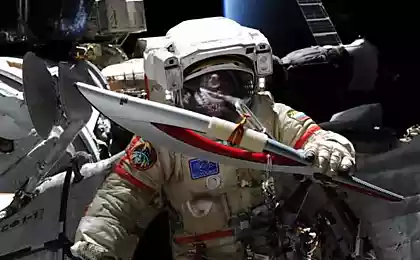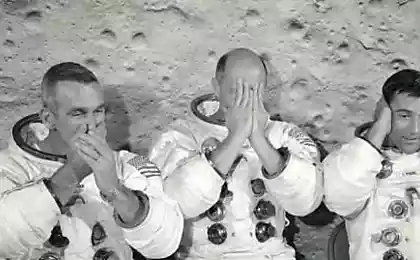Unfulfilled expectations: what is planned and what happened in the "Space Shuttle"

One of these days happened to notice that five times in comments posted on the question of the degree of success of the program "Space Shuttle". Such regularity issues requires a full article. In it I will try to answer the questions:
- What are the goals to put the program "Space Shuttle»?
- What was the result?
Subject reusable media is very extensive, so in this article I specifically limited to these issues.
What is planned? H4>
The idea of the shuttle occupied the minds of scientists and engineers in the United States with more 50s. On the one hand, I'm sorry to break the ground dropped the exhaust stage. On the other hand, the device that combines the properties of aircraft and spacecraft will be in line with the Jets philosophy where reusable natural. Various projects were born: X-20 Dyna Soar , Recoverable Orbital Launch System (later Aerospaceplane). In the sixties, this inconspicuous enough activity continued in the shadow program "Gemini" and "Apollo." In 1965, two years before the flight "Saturn-V», was established a subcommittee on technology reusable launch vehicles at the Coordinating Council for Air and Space Operations (which was attended by the US Air Force and NASA). The result of this work was a document issued in 1966, stating the need to overcome serious difficulties, but was promised a bright future for Earth orbit. At the Air Force and NASA had a different vision of the system and different requirements, so instead of one project were presented ideas ships of various layout and degree of reusability. After 1966 NASA began to think about creating a space station. This implies the need to station a large number of delivery of cargo into orbit, which in turn raises the question of the cost of such delivery. In December 1968, a working group, which was engaged in the so-called Joint Machinery launch and landing Integral Launch and Reentry Vehicle (ILRV). Report this group was submitted in July 1969 and claimed that ILRV should be able to:
- Implementing the space station
- Run and return from orbit satellites
- in orbit boosters and payload
- in orbit fuel (for subsequent charging other devices)
- maintain and repair satellites in orbit
- Provide short manned mission
In parallel, in February 1969, President Nixon established a working group whose task was to determine the direction of movement in space exploration. The result of this group was the recommendation of creating a reusable spacecraft that would:
- Become a fundamental improvement of existing space technology in terms of value and volume into orbit
- transport people, cargo, fuel, other ships, boosters and stuff into orbit as the plane - regular, cheap often and a lot.
- Must be versatile for compatibility with a wide range of civilian and military payloads.

This combination was the theoretically cheap to operate. However, the requirement of a large payload makes the system too much (and, hence, expensive). In addition, the military wanted the possibility of horizontal maneuvers of 3000 km for landing at the Baikonur launch on the first turn of the a polar orbit abbr>, which limited engineering solutions (for example, it becomes impossible straight wings).
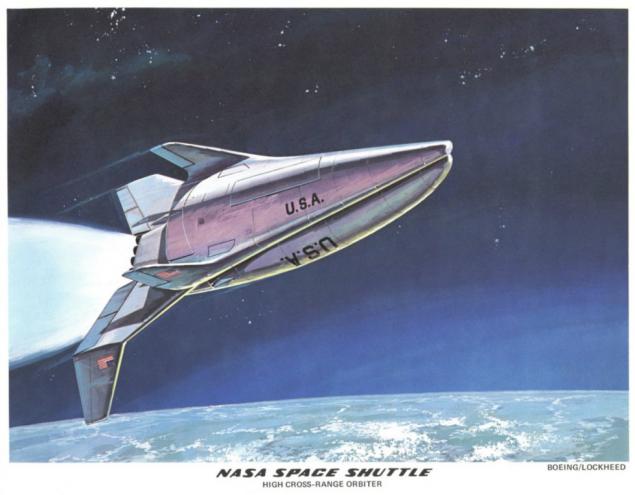
Judging by the signature «high cross-range» (large horizontal maneuver) This picture is liked war i>
The final layout is very strongly dependent on the following requirements:
- The size and capacity of the cargo compartment
- The amount of horizontal maneuver
- Engines (type, traction and other parameters)
In around 1970 it became clear that the space station and the shuttle while money is not enough. And the station for which the shuttle had to haul cargo, has been canceled.
At the same time in an engineering environment reigned unbridled optimism. Based on the experience of operation of the experimental rocket planes ( X-15 ), engineers predicted cost reduction kilograms into orbit two orders of magnitude ( a hundred times). At a symposium on the program "Space Shuttle", which took place in October 1969, the "father" of the shuttle George Müller a > said:
What do you get? H4>
Now, when the program is finished, it is possible with sufficient accuracy to tell what goals have been achieved, and what - no.
Achieved goalsDelivery of goods of different types (satellites, boosters, segment of the ISS). Ability to repair satellites in low Earth orbit. Ability to return to Earth satellites. Ability to send a flight of up to eight people. Implemented reusable. implemented a new layout of the spacecraft. Ability to horizontal maneuver. Large cargo bay. The cost and development time to meet the deadline promised by President Nixon in 1971.
not achieve their goal and dips Quality facilitating access to space. Instead of reducing the price per kilogram of two orders of magnitude, "Space Shuttle" has become one of the most expensive means of delivering satellites into orbit. Fast preparation shuttles between flights. Instead of the expected period of two weeks between the flight shuttles ready to launch for months. Before the disaster "Challenger" record was 54 between the flights of the day, after the "Challenger" - 88 days. In all the years of operation of shuttles are launched an average of 4, 5 times a year instead of the minimum allowable by calculations of 28 times a year. Easy maintenance. Selected technical solutions have been very time-consuming to maintain. Main engines require removal and a lot of time on the service. Engine turbopump assembly of the first model required a full bulkhead and repair after each flight. Thermal protection tiles were unique - in each slot was set their own tiles. Total of 35 000 tiles, moreover, they can be lost or damaged in flight. Replace all disposable carrier. Shuttles never launched into polar orbit that is necessary for reconnaissance satellites. Were preparatory work, but they were stopped after the disaster "Challenger». A reliable access to space. Four orbiter meant that the space shuttle disaster - a loss of a quarter of the fleet. After a disaster, flights stopped for years. Also, the shuttles were notorious for constantly postponed starts. Load shuttle was five tons below the required specifications (24, 4 instead of 30) Large horizontal maneuver opportunities have never been used in reality from -this fact that the shuttle did not fly into a polar orbit. Return satellites orbit stopped in 1996. From orbit was returned all five satellites. Repair satellites, too, was weak demand. Total has been renovated five satellites (though Hubble served five times). Accepted engineering solutions adversely affect the reliability of the system. During takeoff and landing areas have been no chance of rescue of the crew in an emergency. Because of this death "Challenger". Mission STS-9 nearly ended in catastrophe because of a fire in the rear, which appeared already on the runway. Had this fire a minute earlier, the shuttle would have fallen without the chance of rescue of the crew. The fact that the shuttle is always flown manned at risk people without the need - for routine satellite launch lacked automation. Because of the low intensity of use shuttles morally outdated sooner than physically. In 2011, "Space Shuttle" was a very rare example of operation of the processor 80386 Disposable carriers could gradually upgrade the new series. Closing the program "Space Shuttle" superimposed on the abolition of the "Constellation", which led to a loss of self access to space for many years, image losses and need to buy a place in spaceships other countries. The new control system and nadkalibernye fairings allowed to run at large satellites disposable rockets. The shuttle holds a sad antirecord among space systems by the number of people killed.
The "Space Shuttle" gave the United States a unique opportunity to work in space, but in terms of difference "that would - that got" we must conclude that it has not achieved its goals.
Why did it happen? H5>
Especially emphasize that at this point I express their views, perhaps some of them are wrong.
Hey, "Buran»? H5>
Anticipating the inevitable comparisons have little say about him. According to the "Buran" no statistics operation for many years. With it turned out something simpler - it covered rubble collapse of the USSR, and we can not say this program would be successful. The first part of this program - to "do as the Americans have" completed and that it would be more - is unknown.
And willing to arrange in the comments holivar "Which is better?" I ask beforehand to define what you think is "better". Because both the phrase "Buran has a large stock of characteristic velocity (delta-V), than the Space Shuttle" and "Space Shuttle does not reset expensive boosters with stage rocket" true.
List of sources (not including Wikipedia):


